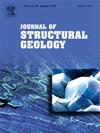澳大利亚西部紧邻阿尔巴尼-弗雷泽造山带的伊尔冈克拉通黑云母氩年龄谱的模拟和建模
IF 2.9
2区 地球科学
Q2 GEOSCIENCES, MULTIDISCIPLINARY
引用次数: 0
摘要
在这里,我们通过演示如何估计古深度及其随时间的变化,进一步展示了如何使用基于氩气地质年代学的建模来开发自然环境中单个样品所遵循的温度-时间路径的性质的约束。该方法一般适用于任何具有发育良好的年龄平台的黑云母年龄谱的解释,只要在初始阶段有相对较小的明显的放射成因氩的损失,并且只要这些初始阶段没有被过量氩的释放所掩盖。准确的模拟依赖于所测年龄谱的形态描述,特别是在初始加热步骤中。必要的细节取决于在分步加热过程中对温度变化的精确控制,以及等温物有足够的质量来进行多次分步加热。在这里,我们数值模拟了一个单一年龄谱的形态,该谱是由从澳大利亚西部伊尔加恩克拉通Kalgoorlie地块的单一样品中分离出来的黑云母颗粒的阶梯式加热产生的。样品位置距离太古代伊尔冈克拉通与奥尔巴尼-弗雷泽造山带(AFO)分离的断层推断位置不到15公里。因此,年龄谱可能反映了中元古代与伊尔冈克拉通并置有关的热扰动。没有明显的影响意味着AFO的高级部分在并置之前已经冷却,并且/或者来自Yilgarn克拉通的样品已经处于如此浅的地壳水平,以至于在并置期间它几乎没有受到与边缘正交的任何推力的影响。本文章由计算机程序翻译,如有差异,请以英文原文为准。
Simulation and modelling of an argon age spectrum from biotite in the Yilgarn Craton immediately adjacent to the Albany–Fraser Orogen, Western Australia
Here we further show how modelling based on argon geochronology can be used to develop constraints as to the nature of the temperature–time path followed by an individual sample in the natural environment, by demonstrating how to estimate palaeodepth, and its variation through time. The method is of general application to the interpretation of any biotite age spectrum with a well-developed age plateau, as long as there is relatively minor loss of radiogenic argon evident in the initial steps, and as long as those initial steps are not masked by the release of excess argon. Accurate simulation relies on how well the morphology of the measured age spectrum has been delineated, especially in the initial heating steps. The requisite detail depends on precise control of temperature variation during step-heating, and on the aliquot having sufficient mass to allow many steps. Here we numerically model the morphology of a single age spectrum produced by step-heating an aliquot of biotite grains separated from a single sample from the Kalgoorlie Terrane, in the Yilgarn Craton, Western Australia. The sample location is less than 15 km from the inferred location of the fault that separates the Archean Yilgarn Craton from the Albany-Fraser Orogen (AFO). Potentially therefore the age spectrum should reflect thermal disturbance related to the juxtaposition of the AFO against the Yilgarn Craton during the Mesoproterozoic. The absence of significant effects implies that the high-grade portions of the AFO had cooled prior to their juxtaposition, and/or that the sample from the Yilgarn Craton was already at such shallow crustal levels that it was little affected by any thrusting orthogonal to the margin during juxtaposition.
求助全文
通过发布文献求助,成功后即可免费获取论文全文。
去求助
来源期刊

Journal of Structural Geology
地学-地球科学综合
CiteScore
6.00
自引率
19.40%
发文量
192
审稿时长
15.7 weeks
期刊介绍:
The Journal of Structural Geology publishes process-oriented investigations about structural geology using appropriate combinations of analog and digital field data, seismic reflection data, satellite-derived data, geometric analysis, kinematic analysis, laboratory experiments, computer visualizations, and analogue or numerical modelling on all scales. Contributions are encouraged to draw perspectives from rheology, rock mechanics, geophysics,metamorphism, sedimentology, petroleum geology, economic geology, geodynamics, planetary geology, tectonics and neotectonics to provide a more powerful understanding of deformation processes and systems. Given the visual nature of the discipline, supplementary materials that portray the data and analysis in 3-D or quasi 3-D manners, including the use of videos, and/or graphical abstracts can significantly strengthen the impact of contributions.
 求助内容:
求助内容: 应助结果提醒方式:
应助结果提醒方式:


